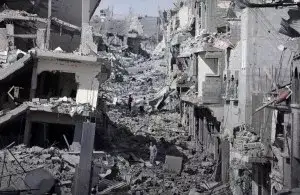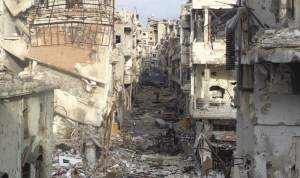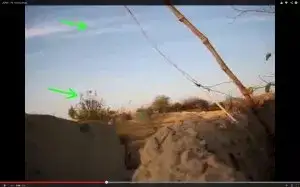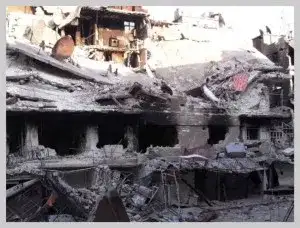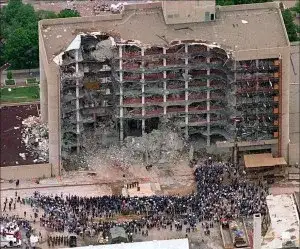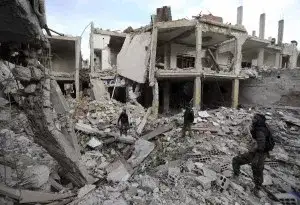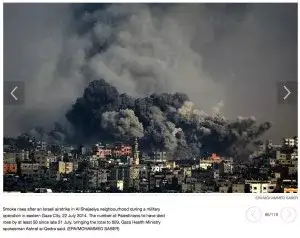Battle damage: Gaza versus Syria
August 11, 2023 by Thomas Wictor
It appears that the ground phase of Operation Protective Edge is over. Now that the Israelis are aware of the Hamas tunnel threat, they can prepare for future attacks. Hamas—always inconceivably stupid and depraved—has murdered the tunnel diggers to silence them. Good luck recruiting new diggers to replace the tunnels that the IDF destroyed. To ensure that Israelis understand that Hamas was responsible for most of the destruction, here’s a comparison of battle damage, Gaza versus Syria.
First, you MUST remember this: Hamas set off over a thousand improvised explosive devices (IEDs) or booby traps in a tiny, densely-populated strip of land. That number dates from eleven days ago. Each of those bombs took out several buildings.
Look at this slideshow of Gaza, and you’ll see that the press—in its lust to implicate the Israeli Defense Forces in war crimes—actually provides the evidence that Hamas IEDS caused the vast majority of the devastation.
You can’t ask for a better comparison than these two images.
First, Gaza.
Next, Syria.
Can you tell what’s missing in the Gaza photo? Fragmentation damage. On the Gaza street, every single surface is pristine. Now look at all the holes in the buildings on the Syrian street. Those come from explosive aerial munitions, artillery shells, tank shells, missiles, mortars, and heavy machine guns.
Notice how in the Gaza photo, the buildings appear to have been shaken apart. That’s because horizontal pressure waves hit them.
This is the shock wave of the heaviest Israeli aerial bomb, the MK-84, called the GBU-31 when converted to a precision-guided munition.
The MK-84 has a lethal fragmentation radius of 400 yards (366 meters), but the pressure wave dissipates quickly, as you can see in the video. Since the bomb itself is about thirteen feet (four meters) long, we can do an unscientific, visual calculation of how far the most intense shock wave travels. It works out to about 78 feet (24 meters) from the epicenter of the explosion.
If Israeli aerial munitions caused the damage on the Gaza street, there should be holes everywhere, because it would’ve required several bombs to create so much pressure.
Watch a GBU-31 bomb exploding 230 feet (seventy meters) from American troops in Afghanistan.
I wondered why the mushroom cloud had a double head; it’s because there are actually two bombs. If you listen carefully, you can hear two explosions.
More proof that Israeli aerial munitions aren’t producing the destruction in Gaza. Those American soldiers were completely unaffected by the pressure wave from two GBU-31s exploding simultaneously.
Another image from Gaza. No fragmentation damage WHATSOEVER.
Now Syria again. Holes everywhere, and the contents of the building caught fire from high explosives or incendiaries.
The Alfred P. Murrah Federal Building in Oklahoma City was destroyed by a truck-borne IED on April 19, 1995. Timothy McVeigh carefully arranged the ammonium nitrate/fuel oil (ANFO) bomb inside the truck to explode sideways and knock out the support columns. As a result, the front of the building slid off.
No signs of fragmentation or burning, just like in most of the photos from Gaza.
Some structures in Syria have been demolished by IEDs. For example, these buildings are damaged in exactly the same way as those in Gaza.
You know why? Because in the Syrian Civil War, both sides use IEDs. Here’s a gigantic jihadist truck bomb.
It caused a huge secondary explosion, which you can see on the right. The pressure wave from such a bomb would be immense.
While the jihadists use ground-based IEDs, the Syrian Arab Army drops aerial versions called “barrel bombs”—cylindrical metal containers filled with explosives and sometimes fitted with aerial fins.
Those explosions look mighty familiar, don’t they? In Operation Protective Edge, the press keeps attributing smoke clouds like that to Israeli “air strikes,” but they’re IEDs. No question.
In this photo of Gaza, at least three IEDs are going off, either because Hamas detonated them, or because they blew up after the Israelis bombed them.
The IDF simply does not have munitions big enough to take out an entire city block. Only one kind of weapon used in Gaza can do that: the IED.
Besides, it’s against the IDF’s interests to create mounds of rubble. Read about the Battle of Monte Casino. After the Allies bombed the abbey, the Germans had a million places to hide. It’s one of the major mistakes of World War II.
So why is the Syrian Arab Army flattening so many cities? Because the SAA an incompetent, dysfunctional organization. When all you have is a sledgehammer, everything becomes a nail.
Look at these ugly, dirty, unprofessional bozos who don’t even have safety harnesses. They light their IED with cigarettes and shove it out the back door of the helicopter, not knowing or caring who it kills. The second half of the video is simply a repeat of the first, so you can skip it.
This is the reason Syria leaves Israel alone. The SAA is a rabble of atrocity committing Third Worlders, no different from the jihadists they’re fighting.
One final cause of the destruction in Gaza is IEDs in tunnels. Hamas sent trainers to Syria to teach the rebels how to create tunnel bombs. Here’s video of one.
It happened dozens of times in Gaza.
I say this to Israelis and the world, even though the world will reject it: The forensic evidence shows that the overwhelming majority of the damage caused in Gaza was the result of Hamas IEDs. They were exploded by terrorists, Israeli air strikes, or Israeli engineers. If the Israelis detonated them, they ALWAYS warned civilians to leave first.
Hamas is responsible for the destruction in Gaza. The lies about the Israeli Defense Forces don’t stand up to even five minutes of scrutiny.
Treat your troops well, Israel. They’re absolutely stunning in their skill and altruism.

